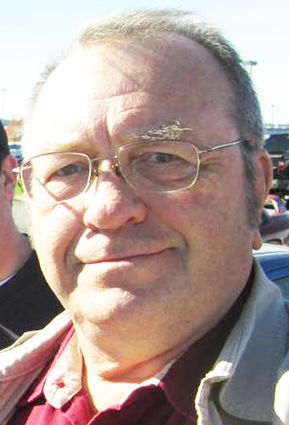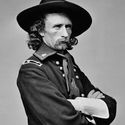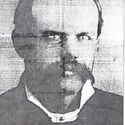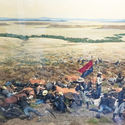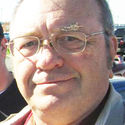The Frank Finkel Story
Did Dayton pioneer survive the Battle of the Little Bighorn?
March 12, 2020
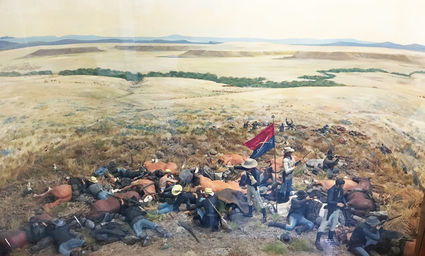
-Chronicle photo by Loyal Baker
This painting hangs in the Custer Battlefield Interpretive Center near Crow Agency, Montana. The late Frank Finkel, one of Dayton's early pioneers, contended that he was a survivor–perhaps the only survivor–of General George Armstrong Custer's 7th Cavalry.
By Gary Lentz
Retired Ranger
Lewis and Clark Trail State Park
Special to the Dayton Chronicle
DAYTON–Was the late Frank Finkel, who arrived in Dayton in 1878, two years after the infamous "Custer's Last Stand," actually a survivor of the battle? That topic was the subject of a talk given by retired park ranger Gary Lentz at the Blue Mountain Heritage Society's 12th Annual Ground Hog Dinner fundraiser here February 1.
Lentz, former ranger of the Lewis and Clark Trail State Park between here and Waitsburg, was always soliciting local residents for any history of the park, and one day received two visitors, Gordon Bateman and his brother Wayne.
"It was one of my best days at the park," Lentz remembered.
The brothers had a shoebox full of memorabilia about the unique slice of the Touchet Valley, having grown up there and been a part of the landscape during their formative years. The walked the grounds and recalled events and details for Lentz for four hours that day.
As the Batemans were preparing to leave, Gordon Bateman asked Lentz if he was a fan of the Battle of the Little Bighorn, which took place June 25-26, 1876, in Montana.
"He said 'well, you'll be interested in this', and he told me about Frank Finkel for the next four hours," Lentz said.
I was fascinated. From that point on, he and I researched together and tried to find the answers to some of the questions
I'm surprised, after a while, that a lot of people in Dayton didn't even know who he was
And the people who did know, didn't really talk about it too much
"The thing to keep in mind is, 'this is our story,'" Lentz said. "This belongs here in southeast Washington, and I want you to understand that before we even begin." Here's Lentz's presentation:
Was there a survivor of General Custer's direct command? In other words, of the 210 men who were with him [Custer]-the command was scattered out over the battlefield-the Last Stand Hill had 210 men.
And since nobody survived that battle on the American side, and only the Indians had their versions to tell, for a long time, nobody knew exactly what Custer had done after the time he was last seen.
Over the years, many people have claimed to have survived that battle, or been there and saw what happened. Of the 70 or so people who have made that claim, none of them were credible. Except maybe one.
It's 1912, Walla Walla, Washington. If you've been downtown Walla Walla, you've seen the Keylor Grand Building.
It's H & H Sports Loan now. The present owners have a book that shows what the theater looked like in 1912.
Why is this building important to the Finkel story? Movies were projected in existing theaters back then and they were a novelty. It wasn't until 1905 that big theaters began to pop up across the country. In 1912 we had one in Walla Walla.
If you lived in Dayton and you wanted to go to Walla Walla, and wanted to take your wife or husband, and wanted to have a nice time in town, how did you get there?
On this particular evening in autumn of 1912, the movie on the bill was a 101 Bisons Production of "Custer's Last Plight." [Now available on DVD.]
It was a silent movie, but Lentz believes it is the most accurate Custer movie ever made, and Hollywood has not done justice to that story since, he said.
However, there's a little more to that story. A well-to-do gentleman and his wife took the Doodlebug, from Dayton to Walla Walla, and while there in 1912, they went down to see the movie.
Somewhere in the middle of the movie, the man stood up and told his wife, 'we're leaving.'
As the movie continued, the two walked out. The wife asked her husband why he wanted to leave.
Outside he told her: 'That's not the way it was.' Imagine that!
His wife knew that her husband had been shot once in the past. She had asked him about it: "What happened to you, Frank? Why do you have that wound there?"
And he said, in his terse way: "An Indian shot me."
And she couldn't pry any more out of him, Lentz said. He didn't want to talk about it. He didn't tell her any more than that. And she didn't pry it out of him.
On the way home, being the good wife that she was, she did pry it out of him.
And he told her a story, and she sat there and must've been aghast. She just had no idea that her husband was that man.
He was 16 years older than her. He had been around a little bit. And he had seen and done things that she really didn't know about. But this story flabbergasted even her.
One day he's playing horseshoes, somewhere in the area (Lentz prefers to think it was at the State Park), had a few beers ("Ja, dis ist gut.") He was German...they like beer. And he said to one of them, "Did you see that movie in Walla Walla?"
One of the guys said "yeah, pretty good movie."
He said, "no." They said "Why not?"
"That's not the way it was."
They said "What, were you there?"
"Yeah, I was."
And he told them the story, and it was a fascinating story, and it was a believable story. And after a few beers, people will believe anything.
Finkel was not a verbose man. He wasn't somebody that talked all the time about everything that he did, but he did tell them this story.
"He says that he was with the Seventh Cavalry at the Battle of the Little Bighorn, and he goes into great detail on what he had done and where he was and what happened.
But as he talks about it, he kind of regrets it, because if the story is true, he would still be technically a deserter in the eyes of the Army, and he doesn't tell it again for another nine years. He just kind of shuffles around, and people ask him their questions, "I got to do something else." he just looks at them and puffs on his cigar and walks away.
People have heard this story, and they ask him again and again, tell us the story.
Frank Finkel successfully dodges the story. But in 1921, the Kiwanis started up here in town. And even then, as they do now, they look for speakers. And they like people to come in and tell them stories about the past, Dayton-how it's doing, all sorts of things.
Of course, Frank Finkel immediately comes to mind. They said 'Frank, come and tell us your story.'
Frank says 'no, I don't think I will. Besides, I'm working on my house and I've got things to do in that house, and I'm doing carpentry work and I can't do it right now.'
Well the Kiwanis, being the clever men that they are, and if you know them here in town, they're very clever...they say 'well, how about if we hire a carpenter, and we'll have the carpenter do the work you wanted done so you can come in and tell this story.'
And so Frank comes in, prepared to tell the story to what he thinks is just the Kiwanis members, but they had two people in the audience, one from the Dayton Chronicle and one from the Walla Walla Bulletin.
Those reporters take down everything he says.
They write the story, very much like he tells it, in great detail, except they get his name spelled wrong.
And everybody spells Finkel wrong, regardless of how you spell it, it's still the same guy.
So Frank Finkel tells the story, and now it goes out in the papers, and the papers go wide and far because this story is incredibly intense at the time. It's been 36 years or so since the battle had happened, but people were still conscious of this.
It was almost like the Pearl Harbor of that time, Lentz said. Everybody knew about it and everybody wanted to know what happened, and why, and so they were fascinated that maybe one of these troopers survived, and they could tell the real story.
Finkel said–and this is part of his story-and there are books out there that will tell you that Finkel is somebody else, somebody other than who we think he is.
And other books say he is who I say he is. And other people say he isn't who you think he is. And that story becomes very confusing.
I can help you sort it out.
He says that he enlisted in Iowa, under the name Frank Hall.
There were a number of reasons for it: he goes into greater detail later in life; he was having some trouble he wanted to get away from home. He wanted to see the world. He wanted to do a number of things. But he didn't want anybody to know where he went. He didn't want to be followed; he had a few debts. So he decided to change his name to Frank Hall and...think of that as I tell you the rest of this story. Don't always think 'Frank Finkel,' kind of think 'Frank Hall.'"
"We tried finding enlistment papers for him," Lentz said. "We found one set that kind of matched him. He said, when he first enlisted, he was stationed in Wyoming, and then later on was transferred to the Seventh Cavalry, probably over in Fort Abraham Lincoln, in North Dakota, just before they set off to find the Sioux Indians and put them back on the reservation.
The plan was to catch them in a three-pronged action: one prong from the east, one from the west, one from the south...catch them and move them back to the reservation.
He was part of that operation. General Gibbon was bringing them in from the west side, General Cook was coming up from the south, General Terry had the eastern column. The name you don't see here is General Custer.
The reason is Custer got himself into some trouble, and was no longer in charge of this. He had told some stories about the president's brother, Orville, and got himself into trouble. And the president said 'you're not leading this expedition.' And so he put General Terry in charge, but he left Custer in charge of the Seventh Cavalry.
So Custer's got his old unit, but he's not in charge of this, but he thinks he is.
And so he does a few things and he makes a few mistakes.
The scouts of the cavalry, once they get over into Montana, they set out, they start looking for sign of the Sioux, and, sure enough, they find signs of the Sioux.
But the Sioux also find signs of them. They know they're out there; they know they're coming their direction, and the Sioux begin to bind together.
Usually, at some point or other, the tribes were enemies, but under the circumstances, they bound together.
The six tribes, including the Northern Cheyenne, bound together. There were anywhere from 1,500 to 3,000 warriors, plus the women and children and elderly and others.
Custer goes after them. He wants to move quickly. General Terry, who was in charge of his command, tells Custer he can take what he wants, Gatling guns, cannon, wagons, whatever is needed. Custer, however, wanted to move fast, and all he needed was horses and a few mules to pull the wagons for ammunition and supplies. "I don't intend to be bogged down," Custer said, with cannons and Gatling guns.
Besides, people had to stand up to shoot those things, and Custer's men weren't equipped to do that.
So he goes out and he moves quickly.
They find sight of the Indians on Rosebud Creek; move up Rosebud Creek, and as they move up, they see more and more sign of Indians.
Custer wanted to surprise them and move more slowly with scouts in all directions. Once he knew he had found the sign and was going to follow it, he was taking his time getting there.
And Finkel mentions this. "He said 'we took our time, and we knew where they were, and we were moving up to catch them,'" Finkel said.
His last camp, on the night of June 24, is still marked. Visitors to the battlefield can see the spot.
From that point on, things got tight, and for many of the men who were with Custer, it would be their last day on earth. And it could very easily have been Finkel's last day, too.
Custer got information from his chief of scouts, Lt. Barnham, who said 'the Indians are telling me that from this high point called the Crow's Nest, we can look down into the valley and we can see worms moving over there.
Custer said "what do you mean, worms?"
He said "there are so many Indians, so many horses, it looks like worms in the grass. And there are more Indians over there than stars in the sky.
Custer dismissed the information, saying the scouts are always exaggerating, Lentz said.
This day he should've paid attention, but he didn't.
And so he did something that almost no commander would ever do. Now, Custer was a hero in the Civil War. He didn't win a Congressional Medal of Honor, like his brother had won two, but he was the youngest general in the Union army. And he had always gone into battle, in front of his troops.
He had been shot at, he had had horses shot out from under him, and he had always been victorious. And he figured he would probably be again, but one lesson he should have learned, Lentz said, is that you never divide your forces in the face of a superior enemy. And he did. He moved his people around.
Lentz showed companies C, E, F, I and L...those five companies in Custer's command, as they came up the Rosebud and Ash creek, it was at that point Custer was last seen.
He sent three companies, A, G and M, under Major Marcus Reno, to attack the end of the village, and to push the Indians toward Custer's companies, Lentz said.
Custer sent Capt. Frederick Benteen, with companies D, H and K, to block the Indians' escape.
B Company had the wagon train, the food, ammunition, medicine and supplies and were isolated.
Reno's men last saw Custer up on a hill.
Now things got really dicey. Companies A, G and M ran into the valley, meeting stiff resistance. "When the Indians saw them attacking, they bunched up and attacked back," Lentz said.
It wasn't long before Major Reno's command was overwhelmed and he was forced to retreat.
Companies D, H and K under Capt. Benteen couldn't find any Indians.
Custer sent a bugler to find Benteen, to convey the message "come quickly and help us, we've found the village."
So Benteen's companies reverse direction, back toward Reno had been.
Co. B under McDougall, Lentz said, had people from other companies, men not in fighting condition but who could guard the wagon train.
Company C, I, F and L are with Custer, and now we listen to what Frank Finkel said, because no one was with him that day who lived to tell about it, other than the Indians' rendition of the battle.
"Frank Finkel said he was in Co. C. Interestingly enough, if you go up to the cemetery [in Dayton], you'll notice that he's buried in cemetery plot C.
"When you find out that Frank Finkel said he was under Tom Custer, George Custer's brother, and during the war he had gotten two Congressional Medals of Honor.
(Lentz said the brothers would have a "tug of war" where George Custer would boast "I was the general" but Tom Custer would say "I won all the medals." So they were true brothers and good friends.)
The path Custer decided to take, we don't know, but here's what Finkel told us: Finkel said that all those men who were fighting down in the valley, they retreated up this hillside and formed a defense position up here on the hill. The Indians, instead of following them or trying to go around them, just "slacked off." The Indians didn't follow the soldiers up the hill, and Reno and his men thought it odd, Lentz said.
Why, after killing half of his command, weren't the Indians just "wiping them out?" Lentz asked.
Reno, short-handed and on the hillside alone, awaits the Indian attack.
Capt. Benteen arrived with the mule train and ordered a defensive position, taking his three companies and the remnants of Maj. Reno's companies, and forming a defensive position on the hill and nothing happened.
A trooper named Weir decided to ride toward the dust, smoke and haze to reconnoiter and was advised against it by Capt. Benteen. He rode to a landmark now known as Weir's Point, caught the Indians' attention, and was attacked. He retreated and from then on, the Indians were "paying attention to that particular command," Lentz said.
Meanwhile, very little firing, and the dust died down in the late afternoon, around 5 p.m. "when all that firing in the distance ceased."
The survivor of Reno's and Benteen's commands, had a "tense night." The Indians were in the village, beating drums, whooping and hollering. The men on the hill knew the next day would probably be their last," Lentz said. They, of course were concerned, and the most concern was "Where's Custer? Why isn't he here? Why isn't he giving us commands? Why isn't he in command?"
The next day, Custer's fate is revealed, Lentz said. "Gibbon said he [Custer] and all 209 troopers with him were killed around that 'Last Stand' area.
So many questions were unanswered. What happened? How did the Indians do this? Were there any survivors? Did Custer try to signal for help? What was Custer's battle plan? What did the survivors at the other end of the battlefield know?
Although it appears there were no military survivors, many people claim they know what happened because they were there and escaped. None of them are credible.
But some of the Indian stories give us some insight. The story is investigated by the U.S. government, universities, private individuals, and historians for decades. The same basic questions remain unanswered.
A lot of theories; a lot of people think they know, but nobody was there to tell us what actually happened, Lentz said.
Flash ahead a few years. Frank Finkel arrives in Dayton, Wash., in 1878. Three years before Dayton was officially incorporated and two years after the Battle of the Little Bighorn.
Now we have a man in town, but he's reluctant to tell you anything, and for all those years, he's in town, he's a successful wheat farmer, he's also bought some acreage over near Fort Benton, Mont., and he spends his time going back and forth doing some farming. He's a quiet man, a well-respected man. Doesn't say much about his military history or anything to do with the military.
But once that paper article came out, Custer historians paid attention.
One of the foremost of his time was this man. Walter Camp was a rail road engineer who mapped the battlefield, and interviewed survivors and witnesses to the battle, and he kept copious notes.
He would interview anybody who was connected with the battle, and in 1910, a lot of those people were still alive. He asked people who were with Reno and Benteen; he talked to Indians; he talked to everybody he could find, asking them exactly what they knew and what happened.
Then he comes across Finkel's story.
Walter Camp was the most highly regarded of his time. He says that Finkels' story, of the 70 he's read, is the most believable of them all, Lentz said.
Time passes, the story fades until it's almost forgotten.
Finkel dies in 1930 and is buried in Plot C in the Dayton Cemetery, but no one but old timers remember.
Lentz remarked that the plaque on the "Pioneer Bridge" in Dayton, includes Frank Finkel's name. The bridge was built in 1930, just before Finkel's death.
–To be continued
